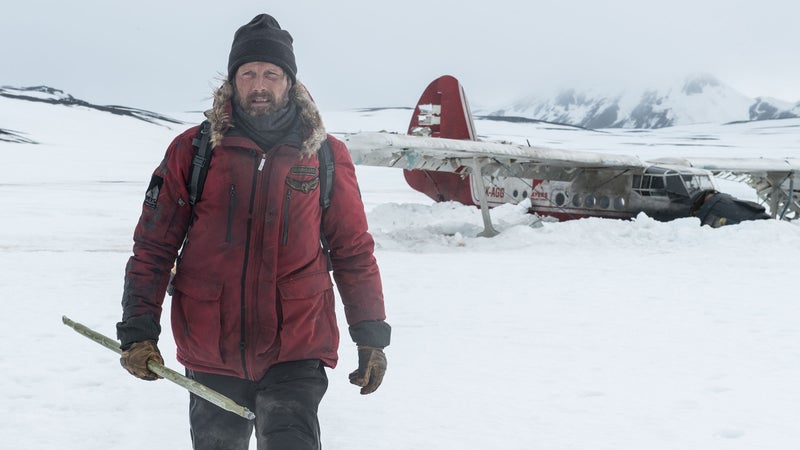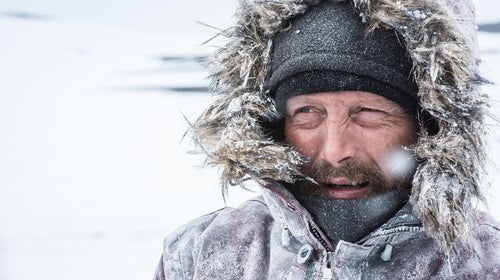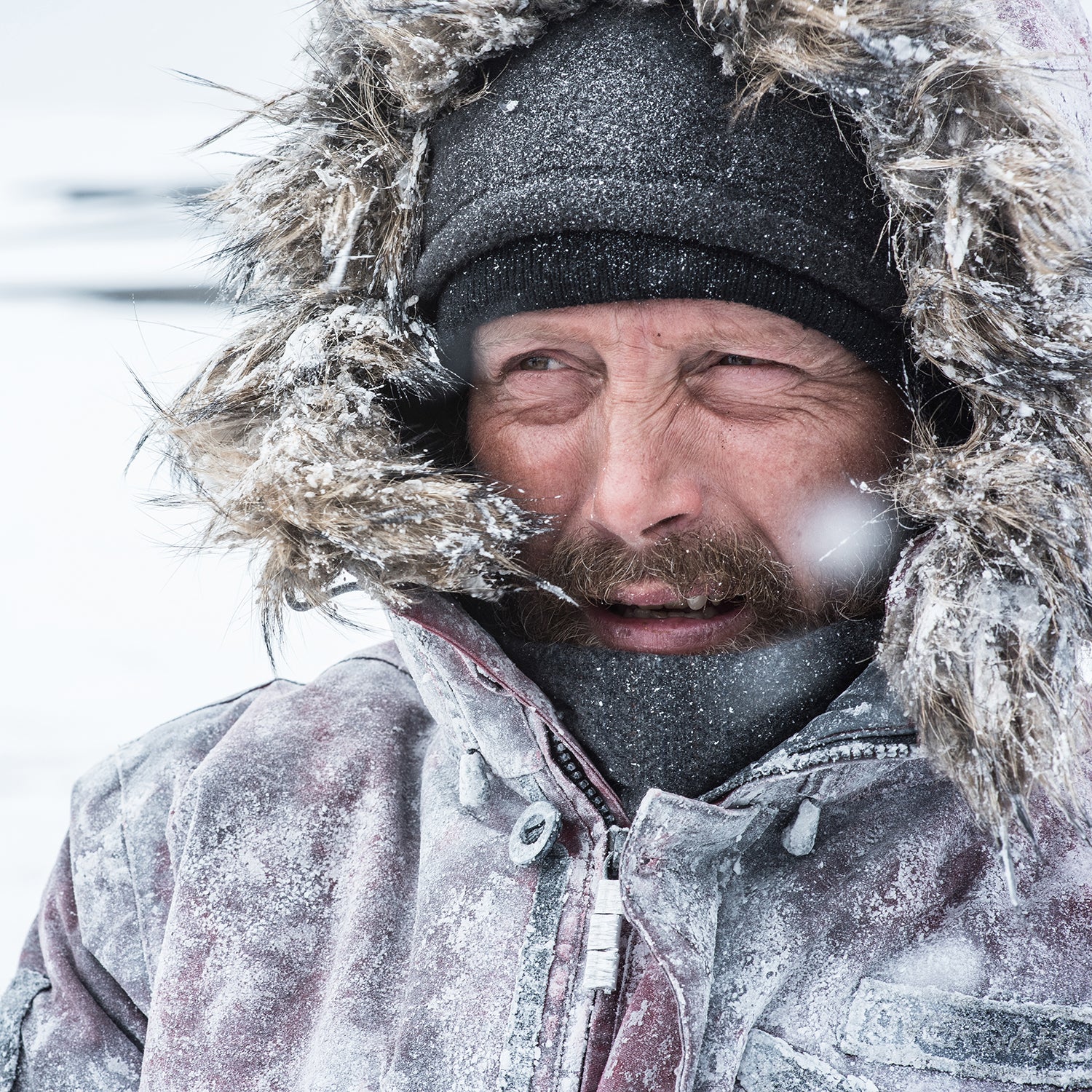It’s a perverse delight to watch a survival film while you’re cradled in the safety of a plush theater seat. Still, you might want to go the extra step of packing a down quilt before venturing out to see , the stark, captivating feature debut directed by Brazilian Joe Penna that comes out this Friday. The film, which premiered at last year’s Cannes Film Festival, chronicles the frigid travails of a pilot named Overgard (played by a nearly wordless but still magnetic Mads Mikkelsen), stranded in the Arctic after his plane crashes. Penna filmed the movie in a desolate, wind-whipped stretch of Iceland, and while he might seem like , his production’s full immersion in that harsh environment resulted in a surprisingly satisfying survival epic.
We meet Overgard about two months into his ordeal as he tends to a large SOS sign built into the snow, part of a daily routine that includes fishing, finding water, and scanning for a radio signal. When the machine eventually begins to beep, it indicates the approach of a rescue helicopter. Unfortunately, the aircraft struggles in violent weather and crashes. Instead of finding salvation, Overgard becomes rescuer to the sole survivor, a woman (played by Maria Thelma Smáradôttir), who remains unnamed and almost completely unresponsive throughout the film. After ransacking the helicopter for useful gear, Overgard transports the gravely injured woman to the shelter of his own wrecked plane, and her care becomes yet another task on his endless Arctic chore wheel. From here, the story arc shifts to a harrowing tale of dual survival, as Overgard strikes out across the bleak landscape, hauling his barely conscious companion along in a sled in hopes of finding rescue.
Arctic is a gripping watch, but given Hollywood’s history of botched survival films, we wondered just how closely Overgard’s experience matches reality. So we recruited an expert with plenty of Arctic experience to watch the film, too: polar explorer, author, and climate-change activist . Fresh off an attempt at a South Pole solo speed record, Larsen has spent well over a decade skiing, snowshoeing, climbing, and even cycling to the earth’s frosty extremes, including his , which made him the first person to reach the North Pole, South Pole, and summit of Mount Everest within the same year. Larsen told us what he thought Overgard did well and what he could have done better.
Stay Busy to Stay Alive
Throughout the movie, we frequently hear the chirp of Overgard’s digital-watch alarm, an ongoing reminder to stay on top of his daily tasks. Larsen was impressed with his ability to keep moving, a necessary but difficult effort on any Arctic expedition. “Your brain wants to just relax and check out,” he says. “It’s really hard to keep on that schedule and motivate yourself when you feel like that place is trying to kill you. That’s not hyperbole—it literally feels like that, because there’s nothing that sustains human life in that area.”
Don’t Underestimate How Much Food You’ll Need
Speaking of sustenance, when Larsen embarks on an expedition, he carries all of his food, even taking care to preslice items like cheese and salami both for efficiency’s sake and to, say, avoid lopping off a finger if his knife slips while sawing through a frozen block of cheddar. Overgard, however, doesn’t have this luxury, so he takes to ice fishing, stashing his hauls in a homemade cooler packed with snow. (Larsen pointed out that this is kind of silly, considering the entire Arctic is basically an oversized Yeti cooler.) This strategy makes sense, but according to Larsen, Overgard doesn’t spend enough of his day securing food. “The only place where he’s able to get any sort of sustenance is that lake,” he says. “I would have just been fishing nonstop, trying to build up a food stock.”
Cherish Heat Sources
After Overgard scavenges a stove from the downed helicopter, the score quiets as he lights it, then huddles around its warmth. Larsen’s been there. “When we do these expeditions up in the Arctic and the Arctic Ocean, that heat from the stove is the only thing that separates us from animals,” he says. “To have this heat that you’re not producing on your own, as well as this connection to the civilized world, is this amazing experience. The cold is so intense—it’s just beating you down—so literally every time I turn on the stove on an expedition, it’s just like, ahhh.”
Create an Effective Shelter
Larsen thought that Overgard’s digs—the interior of his downed plane’s fuselage—were better than spending the night exposed to the elements, but needed some work. “When it’s minus 20 or minus 10 or zero outside, unless it’s, like, 24-hour daylight, it’s going to be pretty close to that same temperature inside,” he says. Realistically, Overgard should have configured his space differently. “Snow is actually a really good insulator,” says Larsen. “I would have tried to be in a smaller part of that plane, covered it up with snow, and tried to minimize the amount of space that I was using so that it would be as warm as possible inside that area.”

Stay Put and Be Selfish
Larsen also takes issue with Overgard’s decision to go out to find help. He would have stayed at the shelter, especially after witnessing the helicopter crash. “To me, it seems like other people would be out looking for this additional craft with some information on where it was going, because it’s theoretically doing a rescue mission,” he says. If he did choose to strike out, Larsen would have left the injured woman behind, as protected as possible, in the hopes that he’d find help for both of them more quickly. “My number-one thing—and I do this on my expeditions—is being selfish,” he says. “You have to take care of yourself first.”
Travel Efficiently
While we don’t see Overgard posthole all that much, he certainly doesn’t have it easy trying to navigate the unforgiving terrain without anything like snowshoes or skis. “I have to be honest, one of my least favorite things is walking in the snow,” says Larsen. He would have improved his ability to move across the landscape by improvising skis from the sled’s runners.
Pay Attention to Your Layering System
One of the key elements to survival in the Arctic is staying as dry as possible; wet clothing and sleeping bags lose their ability to insulate. To manage this on an expedition, Larsen spends hours each night drying his clothes in a stove-warmed tent. Overgard, of course, doesn’t have the same option when he’s on the move wearing a filthy red parka, a pair of snow bibs, and an assortment of layers. In that situation, Larsen would have paid closer attention to his clothing system. “When you’re traveling and pulling a sled, you’re generating a lot of body heat, so you need to take off a lot of clothes. He’s always traveling in those big layers, which is very unrealistic,” he says. “I’ve been in minus-40 or minus-50-degree temperatures with my gloves and my hat off, just because I’m working so hard pulling a sled.”
Fight Polar Bears with Fire
Early in the film, Overgard spots polar-bear tracks near his camp, something Larsen has dealt with during multiple expeditions. “It’s very stressful, because you know that you’re not the top of the food chain,” he says. “You’re in an environment where this animal, one of the supreme predators on the planet, can live comfortably without effort and can very easily eat you.” He’s had to discharge flares to scare off bears, just as Overgard does in the film. “In that situation, you’re like, Now he doesn’t have that flare to use to signal a helicopter,” says Larsen. “Well, he’s alive, at least. If he hadn’t done that, he would have gotten eaten.”
Embrace the Silence
The film is notable for its stark silence, something Larsen experienced during his recent South Pole solo speed attempt. “I really related to that kind of quiet, deliberate thoughtfulness,” he says. “You’re focused on the task, you’re living in your own mind, so a lot of the time it’s not necessary to talk.” Still, he always brings music along to keep him company. The song that soundtracks his own Arctic epics? “Eye of the Tiger” by Survivor, says Larsen. “No way to not be a badass when that song is playing in the background.”


